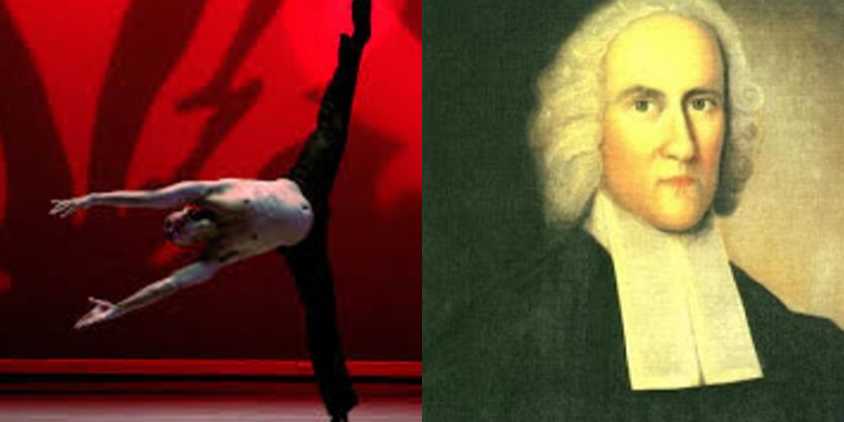Wading through Jonathan Edwards’ “Sinners in the Hands of an Angry God” is a challenge for any American Literature class. TWM’s solution: Song, Dance, and Metaphor!
First, a riff on metaphor – one of the great inventions of all time.
Metaphor expands consciousness and creates new patterns. It takes us outside of what we expect and thereby enhances description.
In Romeo’s, “It is the East and Juliet is the sun” we not only see a young woman in a different way; we learn about the intensity and overpowering nature of the first rush of young love. The morning sun can delicately color wisps of clouds in the way that innocence and beauty grace a young girl. The morning sun can also be blinding in its intensity, like Romeo’s infatuation with Juliet. We are not used to thinking about women or infatuation as sharing attributes with the sun. With this metaphor Shakespeare expands our minds.
Metaphor can be defined as a method of description in which an object, activity, or idea is equated with something that is fundamentally dissimilar. This equation enriches our understanding of the first thing by transferring or ascribing to it some of the qualities of the second.
Metaphor tweaks the way we see and organize the world. The human mind delights in making patterns. This capacity developed as proto-humankind sought to survive without claws, fangs, or fur. Looking for patterns has served us well as we have come to dominate the earth.
Metaphor thrives on the unexpected and delights by showing something new in what we see. In Homer’s metaphor of the “wine-dark sea” it is unexpected that the sea has attributes of wine. And as anyone who has sailed the Agean Sea can tell you, it is an accurate description.
The scope of metaphor is not limited to figures of speech. The painting of a landscape uses a mixture of line, color, and texture on a canvas, things that are very different than the scene they are used to portray. While the painting is not similar to trees, rocks, hills or fields, it adds to our appreciation and understanding of all those things. And when the landscape is painted by Van Gogh or Monet, what we see is skewed for effect to make the painting even more dissimilar than what it portrays adding even more to our appreciation and understanding. The same is true of a painting that portrays a person. While the image on the canvas is dissimilar to the person being painted, the picture adds to our understanding of the person by the way that line, color, and texture are formed and interact. Picasso’s painting Guernica is not the massacre that occurred when German and Italian warplanes bombed civilians in a village during the Spanish Civil War (1936 – 1939). Nor is the painting equivalent to the horror felt by those who witnessed the event or the empathic reactions of people who heard about the massacre. The shapes and colors of the painting, images that are inherently different than the massacre or our reaction to it, enhance our appreciation and understanding of both. In the same way, the marble, bronze, or wood of a sculpture is different than its subject, but their use in description allows a rich and complex examination of what is being portrayed.
The concept of metaphor extends to all of art and can even enhance the description of philosophy. TWM’s Multi-Media Supplement for Jonathan Edwards’ “Sinners In The Hands Of An Angry God” suggests using the metaphors from the spiritual “Sinner Man” and from the dance “Revelations” to make instruction about Edwards’ Sermon more interesting and more memorable.
The lyrics and music of “Sinner Man” supplement the concept of the sermon with different imagery. The music contributes rhythm and melody, as well as the intonation of the singer’s voice. These amplify Edwards’ concept that sinners cannot evade the power of an angry God and ultimately, when God’s supporting power is withdrawn, sinners will fall to Hell and into the fiery embrace of the Devil.
Choreographer Alvin Ailey and the dancers translate the ideas of the sermon and of the song into movement. By using their bodies to describe the flight, fear, pleading, despair, and ultimate fall of sinners, the dancers add a visceral dimension as well as additional layers of meaning. At one point, the three dancers, no longer supported by God’s grace, represent the fall into the fires of Hell.
The comparison of the sermon, the song, and the dance demonstrates that all artistic expression can be seen as metaphor, using dissimilar objects or activities to enhance the description of the subject of the work. Description through metaphor can enhance the portrayal of just about anything, even the abstract printed-word concepts such as those found in Edwards’ antique though fiery sermon.
Written by James Frieden and Deborah Elliott.




